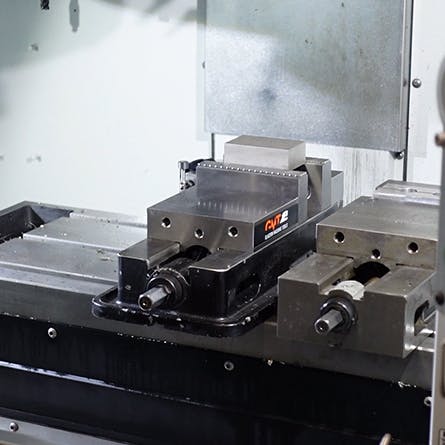
The Benefits of Job Planning and Fixturing
The benefits that can be provided to manufacturers by implementing effective job planning and fixturing in CNC machines are outstanding. These two things, if properly implemented together, can optimize your processes, save you money, and take your business to the next level.

Job planning and scheduling are essential to running a successful manufacturing operation. It allows you to assess capacity, labor, and raw material availability and to choose when to allocate those resources to maximal effect. Meanwhile, fixturing allows you to reduce manufacturing costs - it simultaneously streamlines the process and improves part quality by reducing the potential for errors in the fabrication process. These two things, if properly implemented together, can optimize your processes, save you money, and take your business to the next level. This article will discuss the benefits of job planning and fixturing and how they can impact your business.
The Importance of Job Planning
Balancing the overall supply and demand of a product is the ultimate goal of job planning. Good job planning ensures that manufacturers can maintain smooth and effective operations to not only please their customers with timely deliveries but also to avoid overworking employees. Poor job planning, on the other hand, can spell disaster for any manufacturer. It can lead to missed delivery dates, material shortages, and low morale amongst employees - possibly deterring future employees in the process. Given the amount of manufacturing technology and job scheduling software available in today’s digital age, it is arguably more important than ever to plan jobs effectively and efficiently. Most shops can’t remain competitive and profitable without such planning.
The Benefits of Job Planning
Job planning can help manufacturers stay on top of their incoming orders and resources. If implemented correctly, there are two benefits that particularly stand out:
Visibility and Control of Current Processes
With appropriate job scheduling or enterprise resource planning (ERP) software, a manufacturer can gain full and complete visibility over each of their manufacturing processes, machine capacities, due dates, lead times, inventory, etc. Every item that is critical to running a successful shop can be viewed at a moment’s notice when using ERP software - a fact that helps decision-makers quickly identify and address problem areas.
Since ERP software allows visibility over the overall manufacturing operation, it also gives manufacturers more control over production processes. Manufacturers can effortlessly anticipate and schedule production and easily modify existing orders as needed. With ERP software, a manufacturer can be more proactive and anticipate production issues before they occur.
Identify New Opportunities
Gaining full visibility over an entire manufacturing operation also allows manufacturers to identify areas that can be improved. A well-organized production schedule not only enables manufacturers to recognize bottlenecks in processes but also reveals areas of excessive machine downtime. By efficiently spreading work orders amongst each machining center and solving troublesome production errors, new opportunities become available. This can open the doors for more work and more profit.
The Importance of Fixturing
While effective and efficient job planning is one surefire way to improve production output and profit margins, fixturing is just as essential to improving and optimizing manufacturing processes. Fixturing is the mechanism in which parts — especially complex parts — are held within CNC enclosures so that they can be manufactured with a certain degree of automation. Fixturing allows for high-volume and/or complex operations that simply wouldn’t be possible using a traditional vise. Depending on vice mounting can severely limit a manufacturer’s overall machining capacity. Fixturing, along with a handful of design changes that can be applied to a part, can drive drastic financial savings and simultaneously improve part quality.
The Benefits of Fixturing
Like job planning, fixtures enable manufacturers to improve efficiency and profits. There are three key benefits to implementing fixtures in a machine shop:
Reduced Manufacturing Costs
As stated previously, fixturing can enable manufacturers to automate what would otherwise be manual processes. With proper fixturing, operators no longer have to adjust setups to change the workpiece orientation, tools, or machine programs. Fixtures practically remove the need for setups prior to machining processes (so long as the fixture has not been moved since the last run). Additionally, fixturing allows for complex parts to be machined in a much more efficient manner due to the repeatability they enable. The benefit here becomes much more pronounced as lot sizes increase, driving overall cost per part and manufacturing expenses down even lower.
Improved Part Quality
Due to the repeatability that fixturing provides, your part quality can become more consistent. Fixturing eliminates many opportunities for human error. This improved production capability thus affords you the opportunity to take on larger and more complex part runs since manufacturers seldom have to worry about quality issues. Additionally, using fixtures reduces the likelihood of a machine crashing or a cutter dinging the machine table - reducing maintenance and overhaul expenditures.
Attract More Skilled Workers
The level of automation that is achieved through fixturing can allow manufacturers to cut down on unskilled labor and thus focus on recruiting and retaining more skilled employees. This enables manufacturers to cut costs on labor, invest in more sought-after employees like machine programmers and engineers, and focus on more pertinent tasks.
The benefits that can be provided to manufacturers by implementing effective job planning and fixturing in CNC machines are outstanding. In order to remain competitive in your respective market, these two improvements are an absolute must. Job planning allows manufacturers to improve logistical efficiency and production output by gaining insight into their processes - they can better adjust to the ebbs and flows in supply and demand. Along the way, fixturing allows manufacturers to improve machine processes and gain more business by introducing automation. Depending on the level of automation, manufacturing costs can be significantly reduced and part quality can be improved upon. These two things are key to maintaining a competitive edge and further expanding your market share.
